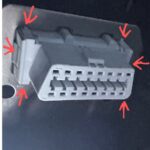Experiencing engine performance issues and seeing the OBDII code P1320 pop up on your scanner can be frustrating. This code generally points towards a problem within your vehicle’s ignition system, specifically related to the ignition coil primary or secondary circuit. If you’re noticing symptoms like engine misfires, hesitation, or rough idling, understanding and addressing the P1320 code is crucial for restoring your car’s performance.
Understanding the OBDII P1320 Code
The P1320 diagnostic trouble code (DTC) is commonly associated with “Ignition Primary Circuit Malfunction” or “Ignition Secondary Circuit Malfunction.” This indicates that the engine control module (ECM) has detected an issue in the electrical circuit that controls one or more of your ignition coils. Ignition coils are responsible for providing the high-voltage spark needed to ignite the air-fuel mixture in each cylinder, and a malfunction in their circuit can lead to misfires and reduced engine efficiency.
Common Symptoms Associated with P1320
When the P1320 code is triggered, you might observe several symptoms, including:
- Engine misfires: This is often the most noticeable symptom. You might feel a jerking or sputtering sensation, especially during acceleration or when the engine is under load.
- Rough idling: The engine may idle unevenly or vibrate excessively when stationary.
- Hesitation or lack of power: The vehicle might feel sluggish or unresponsive when you press the accelerator.
- Decreased fuel economy: Misfires can lead to inefficient combustion, resulting in lower miles per gallon.
- Check Engine Light: The malfunction indicator lamp (MIL), or check engine light, will illuminate on your dashboard.
- Intermittent P0205 code: In some cases, you might also see related codes like P0205 (Injector Circuit Malfunction – Cylinder 5), which can sometimes occur alongside ignition issues due to related electrical problems or misdiagnosis focusing solely on fuel delivery.
Diagnosing and Troubleshooting P1320
Troubleshooting P1320 requires a systematic approach to pinpoint the root cause. Here’s a step-by-step guide to help you diagnose the problem:
-
Inspect the Ignition Coils:
- Visual Inspection: Check for any obvious signs of damage to the coil packs, such as cracks, swelling, or burnt marks.
- Resistance Testing: Use a multimeter to measure the resistance of each ignition coil. Compare your readings to the manufacturer’s specifications. Unusual readings, like excessively high or low resistance, or no reading at all, can indicate a faulty coil. Note: As seen in the original forum post, inconsistent readings, especially on a recently replaced coil, are a strong indicator of a problem.
- Swap Test: If you suspect a specific coil, try swapping it with a coil from a different cylinder. Clear the P1320 code and see if the misfire moves to the cylinder where you installed the suspect coil, or if a different code appears.
-
Check Spark Plugs:
- Condition: Examine the spark plugs for wear, damage, or improper gap. Faulty spark plugs can put extra stress on the ignition coils.
- Type: Ensure you are using the correct type of spark plugs recommended for your vehicle. Using incorrect spark plugs, like the Bosch platinum plugs mentioned in the original post when NGK is recommended, can sometimes contribute to misfire issues and potentially trigger P1320.
-
Examine Wiring and Connectors:
- Visual Inspection: Carefully inspect the wiring harness and connectors leading to the ignition coils. Look for frayed wires, loose connections, corrosion, or damage.
- Continuity Testing: Use a multimeter to check for continuity in the wiring between the ECM and the ignition coils. Breaks or shorts in the wiring can disrupt the circuit and cause P1320.
-
Consider the ECM (Engine Control Module):
- While less common, a faulty ECM can sometimes be the cause of P1320. The ECM controls the ignition system, and internal problems could lead to misdiagnosis of coil or wiring issues. This should be considered after ruling out other potential causes.
-
Address Other Related Codes:
- If you have other codes along with P1320, such as P0205 (IACV – Idle Air Control Valve in the original post was incorrectly associated with P0205, which is actually an injector circuit code), address these as well. While seemingly unrelated, issues with other engine components or sensors can sometimes indirectly affect the ignition system or complicate diagnosis.
Parts to Investigate for P1320
Based on the diagnosis steps, the primary components to investigate for a P1320 code are:
- Ignition Coils: These are the most frequent culprits.
- Spark Plugs: Ensure they are in good condition and of the correct type.
- Ignition Coil Wiring and Connectors: Check for any electrical circuit issues.
- ECM (Engine Control Module): Consider this if other components check out okay.
Resolving P1320 and Misfire Issues
Once you’ve identified the faulty component, replacing it should resolve the P1320 code and related symptoms. If you replaced a coil pack recently and suspect it might be defective, as in the original scenario, consider checking the warranty or replacing it again, even if it’s new. Using quality OEM or reputable aftermarket replacement parts is always recommended for ignition system components.
For car owners facing P1320, a methodical diagnostic approach is key. By systematically checking the ignition system components, wiring, and spark plugs, you can effectively pinpoint the problem and restore your vehicle’s smooth and efficient operation. If you’re uncomfortable performing these diagnostics yourself, it’s always best to consult a qualified mechanic for professional diagnosis and repair.

